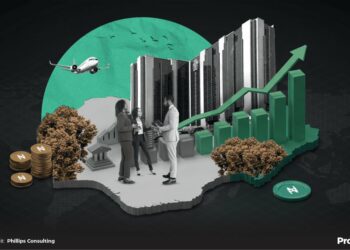In recent years, Nigeria has found itself entangled in a complex web of debt, facing a conundrum that poses significant challenges to its economic stability and long-term development prospects. The country’s escalating debt burden has sparked concerns among policymakers, economists, and citizens alike, raising questions about its sustainability, management, and implications for the nation’s future.
At the heart of Nigeria’s debt conundrum lies a combination of domestic and external factors that have contributed to the accumulation of debt over time. Historically, Nigeria has relied heavily on borrowing to finance budget deficits, fund infrastructure projects, and stimulate economic growth. However, the sustainability of this borrowing strategy has come under scrutiny, particularly in light of the country’s sluggish revenue generation, volatile oil prices, and fiscal mismanagement.
The precarious nature of Nigeria’s debt situation is exacerbated by its dependence on oil revenues, which account for a significant portion of government revenue and export earnings. Fluctuations in global oil prices and production levels render Nigeria vulnerable to external shocks, disrupting fiscal planning and exacerbating budget deficits. As a result, the government has resorted to borrowing to bridge the gap, further increasing the country’s debt burden.
Compounding the challenge is Nigeria’s low revenue-to-GDP ratio, which lags behind peer countries in the region. Despite being Africa’s largest economy, Nigeria’s revenue mobilisation efforts have been hindered by systemic inefficiencies, widespread tax evasion, and a narrow tax base. This revenue shortfall constrains the government’s ability to service its debt obligations, leading to concerns about debt sustainability and potential default risks.
Furthermore, Nigeria’s debt profile is characterised by a mix of domestic and external debt, with varying terms, interest rates, and repayment schedules. While external borrowing offers access to foreign currency and favourable interest rates, it also exposes the country to currency risk and external debt service obligations. On the other hand, domestic borrowing poses risks related to crowding out private sector credit, inflationary pressures, and interest rate volatility.
The implications of Nigeria’s debt conundrum are far-reaching and multifaceted, affecting various aspects of the economy, society, and governance. High debt levels divert scarce resources away from critical sectors such as healthcare, education, and infrastructure, hindering long-term development and poverty reduction efforts. Moreover, the servicing of debt obligations consumes a significant portion of government revenue, limiting fiscal space for essential public services and social welfare programs.
Addressing Nigeria’s debt conundrum requires a multi-faceted approach that addresses both the root causes and symptoms of the problem. In the short term, fiscal discipline, prudent debt management, and transparency in borrowing practices are essential to mitigate debt risks and safeguard macroeconomic stability. Long-term solutions entail structural reforms to diversify the economy, boost revenue mobilisation, and promote inclusive growth.
Moreover, enhancing debt transparency, accountability, and oversight mechanisms is crucial to ensure that borrowed funds are utilised effectively, transparently, and in the public interest. Strengthening institutional capacity, improving governance frameworks, and enhancing public financial management systems are imperative to prevent debt mismanagement, corruption, and fiscal profligacy.
Ultimately, Nigeria’s debt conundrum underscores the need for a holistic and sustainable approach to debt management, anchored in sound economic principles, good governance practices, and social responsibility. By addressing the underlying structural challenges, promoting fiscal sustainability, and fostering inclusive growth, Nigeria can navigate its debt conundrum and chart a path towards a more prosperous and resilient future for all its citizens.





